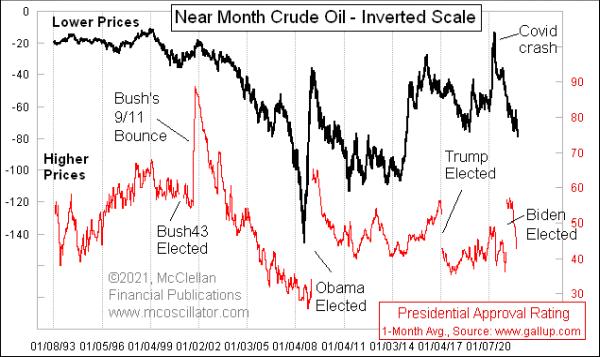
Presidents through the years have professed to care about a lot of different topics and causes. But if they really cared about reelection, they would learn to care more about oil prices.
This week's chart presents an interesting correlation, going back 3 decades, comparing oil prices (inverted) to presidential approval in Gallup's data set. Multiple presidents' ratings are stitched together in this chart in order to allow us to see the effects of changes in oil prices over the years. While actual performance of a president's actual job duties does weigh somewhat on the public's attitudes, it is clear that changes in oil prices matter a whole lot.
Anyone who gets out of the house regularly will likely pass by a gas station and see the current prices of gasoline in 2-foot letters. We therefore have more collective awareness of those price changes than we do for anything else that we purchase, even though gasoline costs now only amount to a very small percentage of the money that we spend. And that awareness historically flows through to how we feel about the guy in the White House.
When President Biden took office on January 20, 2021, crude oil prices were at $53/barrel. Now they have risen to above $80, causing the price plot to drop in the chart above due to the inverted scaling. And his approval according to Gallup has dropped from 57% down to 43%. Oil is not the only factor affecting that change in his approval, but it is definitely a big factor.
On Oct. 8, White House spokesman Jen Psaki was asked about the higher fuel costs, and replied "[c]ertainly we want to keep oil prices low, but the threat of a climate crisis cannot wait any longer." This is reminiscent of President Obama asserting in January 2008, "Under my plan of a cap-and-trade system, electricity rates would necessarily skyrocket." When Mr. Obama took office in January 2009, he enjoyed a 68% initial approval rating, and $40 oil. But as he stayed in office longer, oil prices rose to $113 by April 2011, and his approval rating fell to 40%. When the fracking boom unfolded starting in 2014, President Obama's approval rating started to climb again, and he finished his presidency at 59% approval, and at $51/barrel oil.
Obama's predecessor, George W. Bush, saw the effects of oil prices on his approval rating as well. Right after 9/11, Bush's approval soared to 90% in Gallup's polling, in part because the public did not want to be seen as critical of the president with the country at war. Oil prices were in the low $20s. By July 2008, the commodity indexing bubble had taken oil prices up as high as $145/barrel, and Bush's approval ratings dipped into the 20s.
This all has a markets angle, because of the way that gold prices tend to foretell the future movements of oil prices about 20 months ahead, something I discussed here on September 30.

So if oil prices are going to continue marching higher toward a top, ideally due around April 2022, to match gold's march northward to its August 2020 top, then it would mean that presidential approval rates would continue to fall, responding to that rise in oil prices. That will likely make the mid-term elections in November 2022 all the more contentious.
